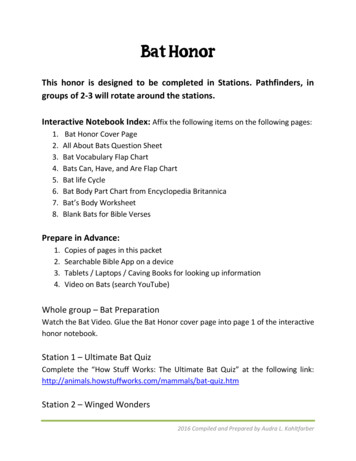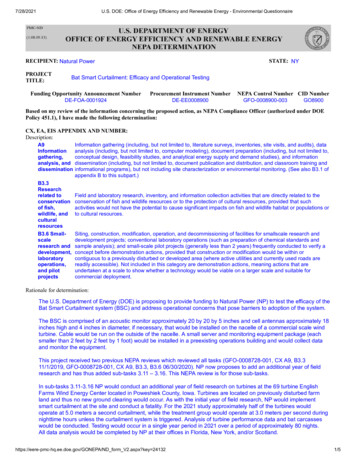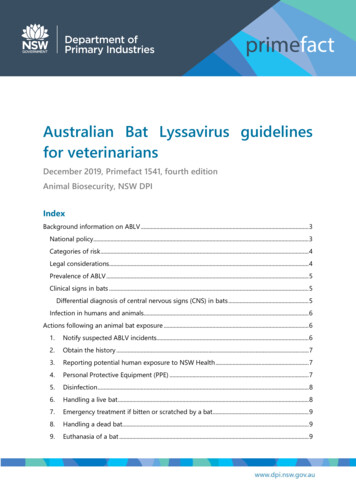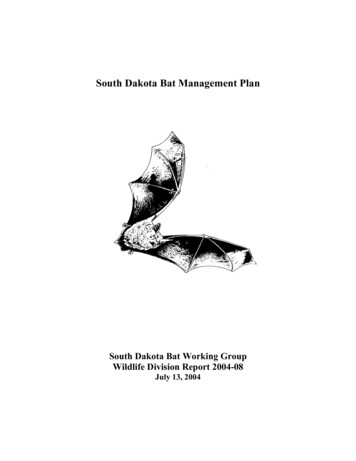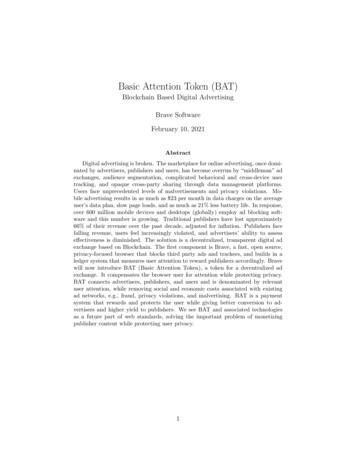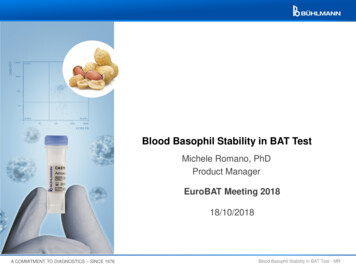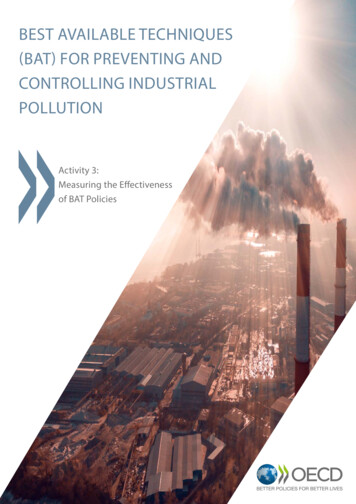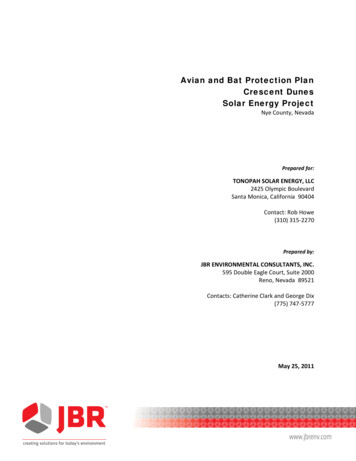
Transcription
Avian and Bat Protection PlanCrescent DunesSolar Energy ProjectNye County, NevadaPrepared for:TONOPAH SOLAR ENERGY, LLC2425 Olympic BoulevardSanta Monica, California 90404Contact: Rob Howe(310) 315‐2270Prepared by:JBR ENVIRONMENTAL CONSULTANTS, INC.595 Double Eagle Court, Suite 2000Reno, Nevada 89521Contacts: Catherine Clark and George Dix(775) 747‐5777May 25, 2011
Table of Contents1.0Introduction . 11.1 SCOPE . 11.2 GOALS OF THE AVIAN AND BAT PROTECTION PLAN . 11.3 IMPLEMENTATION OF THE AVIAN AND BAT PROTECTION PLAN . 21.4 BENEFITS OF AN AVIAN AND BAT PROTECTION PLAN . 21.5 FEDERAL AND STATE AVIAN AND BAT PROTECTION LAWS, REGULATIONS, AND POLICY . 21.5.1 Migratory Bird Treaty Act (MBTA) . 21.5.2 Bald and Golden Eagle Protection Act (BGEPA). 31.5.3 Endangered Species Act (ESA) . 31.5.4 BLM Policy . 31.5.5 Nevada Regulations . 41.5.6 Nevada State Protection and Propagation of Native Fauna . 41.6 ENFORCEMENT OF THE MBTA, BGEPA, AND ESA . 42.0Study Area . 52.1 DESCRIPTION OF PROJECT AREA. 52.2 DESCRIPTION OF PROPOSED PROJECT . 53.0Wildlife Resources . 83.1 MAMMALS. 83.2 GAME SPECIES . 83.3 BIRDS . 83.4 REPTILES . 84.0Species of Interest. 94.1 PROTECTED SPECIES CRITERIA AND UTILIZATION OF PROJECT AREA . 94.2 PROTECTED SPECIES POTENTIALLY OCCURRING WITHIN THE PROJECT AREA . 95.0Threat Assessment . 125.1 AVIAN AND BAT USE OF CRESCENT DUNES PROJECT COMPONENTS . 125.1.1 Central Receiving Tower . 125.1.2 Heliostat Solar Field . 125.1.3 Transmission Lines and Power Poles . 125.1.4 Evaporation Ponds . 125.2 CAUSES OF AVIAN AND BAT MORTALITY . 135.2.1 Collision. 135.2.1.1 Central Receiving Tower . 135.2.1.2 Transmission Lines and Power Poles . 135.2.1.3 Heliostats . 145.2.2 Electrocution . 145.2.2.1 Transmission Lines . 145.2.2.2 Bird Nesting . 155.2.3 Evaporation Ponds . 155.2.4 Burning from Concentrated Solar Energy . 155.3 EFFECTS TO AVIAN AND BATS SPECIES. 16AVIAN AND BAT PROTECTION PLAN – CRESCENT DUNES SOLAR ENERGY PROJECTJBR ENVIRONMENTAL CONSULTANTS, INC.MAY 2011i
5.3.1 Effects From Project Construction . 165.3.1.1 Central Receiving Tower and Heliostat Solar Field . 165.3.1.2 Transmission Lines and Power Poles . 165.3.1.3 Evaporation Ponds . 175.3.2 Effects From Project Operations. 175.3.2.1 Central Receiving Tower and Heliostat Solar Field . 175.3.2.2 Transmission Lines and Power Poles . 185.3.2.3 Evaporation Ponds . 195.3.3 Effects From Project Maintenance . 205.3.3.1 Central Receiving Tower and Heliostat Solar Field . 205.3.3.2 Transmission Lines and Power Poles . 205.3.3.3 Evaporation Ponds . 206.0Avian and Bat Protection Measures and Modifications. 216.1 COLLISION . 216.1.1 Central Receiving Tower . 216.1.2 Transmission Lines and Power Poles . 226.2 ELECTROCUTION. 226.3 EVAPORATION PONDS . 237.0Implementation and Adaptive Management Actions . 277.1 TONOPAH SOLAR ENERGY POLICY . 277.2 AVOIDANCE AND MINIMIZATION . 277.3 ASSESSMENT AND IMPLEMENTATION APPROACHES . 277.3.1 Reactive Approach . 277.3.2 Preventative Approach . 287.4 PERMIT COMPLIANCE. 287.5 PERSONNEL TRAINING . 287.6 AVIAN AND BAT ENHANCEMENT OPTIONS . 297.7 NOISE EMISSIONS . 297.8 QUALITY CONTROL . 307.9 PUBLIC AWARENESS . 307.10 KEY RESOURCES . 318.0Avian and Bat Reporting System . 328.1 PURPOSE OF THE AVIAN AND BAT REPORTING SYSTEM . 328.2 AVIAN REPORTING SYSTEM COMPONENTS . 328.2.1 Detection . 328.2.2 Response and Documentation to Injured, Deceased, and Nesting Birds . 328.2.3 Remedial Action . 338.2.4 Reporting . 338.2.5 Disposal Procedures for Injured, Deceased, and Nesting Birds . 339.0Mortality and Monitoring Studies and Mitigation . 359.1 GOAL AND OBJECTIVES . 359.2 POST‐CONSTRUCTION MONITORING COMPONENTS . 359.2.1 Methods. 35AVIAN AND BAT PROTECTION PLAN – CRESCENT DUNES SOLAR ENERGY PROJECTJBR ENVIRONMENTAL CONSULTANTS, INC.MAY 2011ii
9.39.49.59.69.79.89.2.1.1 Intensity of Mortalities . 359.2.1.2 Detection Rate . 359.2.1.3 Method of Mortalities. 369.2.2 Considerations . 369.2.3 Sampling Design . 369.2.3.1 Strata . 369.2.3.2 Transects . 36TRANSECT LAYOUT . 369.3.1 Central Receiving Tower and Heliostat Solar Field . 369.3.2 Transmission Lines and Power Poles . 369.2.3 Evaporation Ponds . 37SAMPLING ALONG TRANSECTS. 38DATA TO BE PROVIDED . 39ANALYSIS . 399.6.1 Program DISTANCE . 399.6.2 Program MARK. 39ADAPTIVE STRUCTURE . 39MITIGATION . 4010.0 Literature Cited . 41List of FiguresFigure 1 – Typical Footprint for a Circular Solar Facility . 39List of AppendicesAppendix AAppendix BAppendix CAvian Incident and Nest Assessment FormsPartial List of Avoidance and Minimization Measures for Non‐Operational ImpactsEvaporation Pond Operations DiscussionAVIAN AND BAT PROTECTION PLAN – CRESCENT DUNES SOLAR ENERGY PROJECTJBR ENVIRONMENTAL CONSULTANTS, INC.MAY 2011iii
List of BTANACNDOWNMFSNNHPNRSREATSEUSFWSAvian and Bat Protection PlanEdison Electric Institute’s Avian Power Line Interaction CommitteeAvian Protection PlanBald and Golden Eagle Protection ActBureau of Land ManagementCrescent Dunes Solar Energy Projectconcentrating solar powerDraft Environmental Impact StatementEndangered Species ActFederal Aviation Administrationheat transfer fluidMigratory Bird Treaty ActNevada Administrative CodeNevada Department of WildlifeNational Marine Fisheries ServiceNevada Natural Heritage ProgramNevada Revised StatutesResource Equivalency AnalysisTonopah Solar Energy, LLCU.S. Fish and Wildlife ServiceAVIAN AND BAT PROTECTION PLAN – CRESCENT DUNES SOLAR ENERGY PROJECTJBR ENVIRONMENTAL CONSULTANTS, INC.MAY 2011iv
Avian and Bat Protection PlanCrescent Dunes Solar Energy ProjectNye County, Nevada1.0Introduction1.1SCOPEAn Avian and Bat Protection Plan (ABPP) is a project‐specific document that delineates a programdesigned to reduce the potential risks of avian and bat mortality that may result from the interaction ofthese animals with project facilities.In September 2010, the Bureau of Land Management (BLM) prepared the Tonopah Solar Energy, LLC,Crescent Dunes Solar Energy Project, Draft Environmental Impact Statement (DEIS). The DEIS provides aproject‐specific analysis of the potential impacts to bats and birds resulting from the proposed CrescentDunes Solar Energy Project (CDSEP). Tonopah Solar Energy, LLC (TSE) has voluntarily prepared this ABPPin compliance with federal regulations to outline project‐specific practices and measures for reducingavian and bat impacts potentially resulting from the project.This ABPP has been developed based on recommendations from the Avian Protection Plan (APP)Guidelines prepared by the Edison Electric Institute’s Avian Power Line Interaction Committee (APLIC)and the U.S. Fish and Wildlife Service (USFWS) in 2005. The APP Guidelines provide guiding principles toutilize in the development of an ABPP and thus reduce avian mortality. The following principles areoutlined in the APP Guidelines: Corporate PolicyTrainingPermit ComplianceConstruction Design StandardsNest ManagementAvian Reporting SystemRisk Assessment MethodologyMortality Reduction MeasuresAvian Enhancement OptionsQuality ControlPublic AwarenessKey Resources1.2GOALS OF THE AVIAN AND BAT PROTECTION PLANThe voluntary implementation of this ABPP will fulfill several goals simultaneously, and fulfillment ofeach of these goals will contribute to the satisfaction of the ultimate goal of all ABPPs: to reduce avianand bat mortality. The goals specific to this ABPP are to:AVIAN AND BAT PROTECTION PLAN – CRESCENT DUNES SOLAR ENERGY PROJECTJBR ENVIRONMENTAL CONSULTANTS, INC.MAY 20111
reduce the potential for avian and bat mortality by implementing specific mortality reductionactions;identify and isolate where avian and bat mortality has occurred or has the potential to occur tominimize future incidents;establish an avian and bat reporting system to document incidents of mortality caused byelectrocution, heat, collision, and other plant‐related features;assist TSE in compliance with state and federal laws regarding avian and bat species to avoid thethreat of penalties and fines; and,improve TSE’s reliability and services by reducing power outages due to avian and batinteractions and by reducing repair costs due to electrocution of the animals.1.3IMPLEMENTATION OF THE AVIAN AND BAT PROTECTION PLANTSE would do the following to implement the ABPP and thus accomplish the identified goals. Theseactions would also be performed routinely after implementation of the ABPP to ensure goals are notonly met but also maintained. Specifically, TSE would: verify avian and bat mortalities, update mapped data, and develop additional data onconcentrations of avian and bat species which may be impacted by the project facility;identify the environmental and behavioral factors that lead to areas of high avian or bat use andpotentially higher numbers of electrocutions, collisions, and outages;assist in refining criteria and protocols to further avian and bat conservation; and,ensure the accuracy and detail of incident reporting.1.4BENEFITS OF AN AVIAN AND BAT PROTECTION PLANAs the foremost goal central to any ABPP is reduced avian and bat mortality, avian and bat species areperhaps the most obvious to benefit when the goals of the ABPP are accomplished. While this is true,the practical effect of such a plan may also translate to advantages for TSE. Because the ABPP wouldreduce avian and bat mortality resulting from bird and bat interactions with TSE facilities, costsassociated with avian‐ and bat‐related outages could be avoided or held to a minimum. These costs mayinclude monetary losses such as lost revenue during avian‐ and bat‐caused power outages, repair costsfor equipment damaged by avian and bat interaction, or administration and managerial time directedtoward avian and bat conflicts. The ABPP would reduce other costs that extend beyond monetary value,such as those attributed to negative public perception.The voluntary implementation of an ABPP would also support compliance with the state and federalregulations as described in the following section.1.5FEDERAL AND STATE AVIAN AND BAT PROTECTION LAWS, REGULATIONS, AND POLICY1.5.1 Migratory Bird Treaty Act (MBTA)The Migratory Bird Treaty Act (MBTA) (16 U.S.C. 703‐712), which is administered by USFWS, is thecornerstone of migratory bird conservation and protection in the United States. It implements fourtreaties that provide for international protection of migratory birds. The MBTA states: “it shall beAVIAN AND BAT PROTECTION PLAN – CRESCENT DUNES SOLAR ENERGY PROJECTJBR ENVIRONMENTAL CONSULTANTS, INC.MAY 20112
unlawful at any time, by any means or in any manner, to pursue, hunt, take, capture, kill possess, offerfor sale, sell purchase ship, export, import transport or cause to be transported any migratory bird,any part, nest, or egg of any such bird, or any product, whether or not manufactured, which consists, oris composed in whole or part, of any such bird or any part, nest, or egg thereof.” The word “take” isdefined as “to pursue, hunt, shoot, wound, kill, trap, capture, or collect, or attempt to pursue, hunt,shoot, wound, kill, trap, capture, or collect.” In 1972, an amendment to the MBTA resulted in baldeagles (Haliaeetus leucocephalus) and other birds of prey being included in the definition of a migratorybird. The MBTA currently protects more than 800 migratory bird species, including waterfowl,shorebirds, seabirds, wading birds, raptors, and songbirds (USFWS 2008).1.5.2 Bald and Golden Eagle Protection Act (BGEPA)Under the authority of the Bald and Golden Eagle Protection Act (BGEPA) (16 U.S.C. 668‐668d), baldeagles and golden eagles (Aquila chrysaetos) are provided additional legal protection. The BGEPA makesit unlawful to import, export, sell, purchase, barter, or take any bald eagle or golden eagle, their parts,products, nests, or eggs. As used in the BGEPA, “take” includes pursuing, shooting, poisoning, wounding,killing, capturing, trapping, collecting, molesting, or disturbing an eagle.1.5.3 Endangered Species Act (ESA)The ESA (16 U.S.C. 1531‐1544) is administered by USFWS and the Commerce Department’s NationalMarine Fisheries Service (NMFS). USFWS has primary responsibility for terrestrial and freshwaterorganisms, while NMFS has responsibility for marine species. These two agencies work with otheragencies to plan or modify federal projects so that they will have minimal impact on listed species andtheir habitats. Protection of species is also achieved through partnerships with the states, with federalfinancial assistance and a system of incentives available to encourage state participation.Section 9 of the ESA makes it unlawful for a person to “take” a listed species. Under the ESA “take” isdefined as “to harass, harm, pursue, hunt, shoot, wound, kill, trap, capture, or collect or attempt toengage in any such conduct.” Through regulation, the word “harm” has been defined by the Secretary ofthe Interior as “an act which actually kills or injures wildlife by significantly impairing essentialbehavioral patterns, including breeding, feeding, or sheltering.” However, permits for “incidental take”can be obtained from USFWS for take of endangered species which would occur as a result of anotherwise legal activity.1.5.4 BLM PolicyBLM has implemented policies for special status species found on BLM‐managed lands. BLM’s list ofspecial status species includes species that are listed or proposed for listing under the ESA and speciesrequiring special management consideration to promote their conservation and reduce the likelihoodand need for future listing under the ESA. Additionally, all federal candidate species, proposed species,and delisted species (for five years after delisting) will be conserved as BLM sensitive species (BLM2008).AVIAN AND BAT PROTECTION PLAN – CRESCENT DUNES SOLAR ENERGY PROJECTJBR ENVIRONMENTAL CONSULTANTS, INC.MAY 20113
1.5.5 Nevada RegulationsThe state of Nevada has identified wildlife species that are declining in their range throughout Nevadaor are otherwise rare and at risk of extinction. Sensitive and protected animal species are protected inTitle 45 of Nevada Revised Statutes (NRS) (NRS 501.100 through 503.104). Classification of wildlifespecies and related regulations are detailed in Chapter 503 of Nevada Administrative Code (NAC). Takingof these species is allowed only after obtaining necessary permits or authorizations from NevadaDepartment of Wildlife (NDOW).1.5.6 Nevada State Protection and Propagation of Native FaunaNRS 503.584 through 503.589 provide for the protection and propagation of native fauna, includingmigratory birds. The Board of Wildlife Commissioners determines which species will be fully protectedunder this statute (i.e., state of Nevada protected species).1.6ENFORCEMENT OF THE MBTA, BGEPA, AND ESAThe MBTA is a strict liability statute wherein proof of intent is not an element of a violation. Wording isclear in that most actions that result in a “take” or possession (permanent or temporary) of a protectedspecies can be a violation. A violation of the MBTA by an individual can result in a fine of up to 15,000and/or imprisonment for up to six months for a misdemeanor, and up to 250,000 and/or imprisonmentfor up to two years for a felony. Fines may be doubled for organizations. Penalties increase greatly foroffenses involving commercialization or the sale of migratory birds or their parts. Violators of the BGEPAmay be fined up to 100,000 or imprisoned for up to one year, or both. The BGEPA has additionalprovisions where in the case of a second or subsequent conviction of the BGEPA, penalties may beimposed of up to a 250,000 fine or two years imprisonment, or both. Felony violations of the ESA mayresult in fines up to 50,000 and/or one year imprisonment (for crimes involving endangered species)and 25,000 and/or six months imprisonment (for crimes involving threatened species). Misdemeanorviolations of the ESA may result in fines up to 25,000 for endangered species and 12,000 forthreatened species (USFWS 1998).While these acts have no provisions for allowing an unauthorized take, and while the USFWS generallydoes not authorize incidental takes under these acts, the USFWS recognizes that some birds may bekilled even after all reasonable measures to avoid a “take” are implemented. The USFWS Office of LawEnforcement carries out its mission to protect migratory birds not only through investigations andenforcement but also through fostering relationships with individuals and industries that proactivelyseek to eliminate impacts to migratory birds. While it is not possible under the act to absolve individuals,companies, or agencies from liability if they follow these recommended guidelines, the Office of LawEnforcement and the Department of Justice have used enforcement and prosecutorial discretion in thepast regarding individuals, companies, or agencies who have made good faith efforts to avoid the “take”of migratory birds. The voluntary implementation of this ABPP is intended to proactively seek toeliminate impacts to migratory birds at the CDSEP.AVIAN AND BAT PROTECTION PLAN – CRESCENT DUNES SOLAR ENERGY PROJECTJBR ENVIRONMENTAL CONSULTANTS, INC.MAY 20114
2.0Study Area2.1DESCRIPTION OF PROJECT AREAAccording to the DEIS prepared for the project, the project area is located about 13 miles northwest ofTonopah, Nye County, Nevada (BLM 2010a). The DEIS states that the project area encompassesapproximately 2,950 acres, consisting entirely of BLM‐administered public lands within the TonopahResource Management Plan planning area (BLM 1997). The CDSEP would occupy only approximately1,600 acres within the 2,950‐acre area. The 1,600 acres would be within a perimeter security fence, andonly limited, temporary disturbance would occur outside the perimeter fence.The topography of the project area is generally flat with elevations ranging from approximately 5,000 to5,060 feet above mean sea level (BLM 2010a). Six vegetation communities or land cover types weremapped and observed in the project area and include Inter‐Mountain Basins Mixed Salt Desert Scrub,Inter‐Mountain Basins Semi‐Desert Shrub‐Steppe, Inter‐Mountain Basins Active and Stabilized Dune,Inter‐Mountain Basins Greasewood Flat, Intermountain Basins Playa, and Barren Lands (BLM 2010a).The Inter‐Mountain Basins Mixed Salt Desert Scrub cover type accounts for approximately 2,408 acres ofthe total 2,950‐acre project area. The next abundant cover types within the project area are Inter‐Mountain Basins Semi‐Desert Shrub‐Steppe and Inter‐Mountain Basins Greasewood Flat, occurring onapproximately 176 and 120 acres, respectively. According to the DEIS, there are no wetlands, riparianzones, or waters of the U.S. within or near the project area.2.2DESCRIPTION OF PROPOSED PROJECTThe proposed project includes the construction and operation of a 110‐megawatt (nominal) solar powergenerating facility and supporting components. The proposed solar power facility would useconcentrating solar power (CSP) technology to generate electricity. This specific technology usesheliostats/reflecting mirrors to redirect sunlight on a receiver erected in the center of the solar field(referred to as the central receiver). The central receiver consists of a series of tubes through which aheat transfer fluid (HTF) passes and would be constructed to a height of about 653 feet above groundsurface. The HTF used for the proposed project would be a salt in liquid form, which has the viscosityand appearance of water when heated. When solar energy is to be collected, the liquid salt would berouted through the receiver tubes. As the liquid salt passes through the receiver it would be heated bythe concentrated solar energy, and then would be routed to a large insulated tank where it could bestored with minimal heat loss. When electricity is to be generated, the heated salt would be circulatedthrough a series of heat exchangers to generate high‐pressure superheated steam which in turn wouldbe used to power a conventional Rankine cycle steam turbine/generator. Powering of theturbine/generator would produce the actual electricity product. The exhaust steam from the turbinewould be condensed and returned via feed‐water pumps to the heat exchangers, where it would beconverted to high‐pressure superheated steam in a closed cycle. The energy in the heated salt would bedepleted after generating steam and would be routed to the cold salt tank for reuse the next day. Hybridcooling processes would be used for this project to reduce water used for cooling while maintainingefficient power generation.AVIAN AND BAT PROTECTION PLAN – CRESCENT DUNES SOLAR ENERGY PROJECTJBR ENVIRONMENTAL CONSULTANTS, INC.MAY 20115
Major construction and operational components of the project include: Central receiver tower –The concrete tower would be approximately 538 feet tall and wouldhouse a 100‐foot‐tall cylindrical solar receiver and a 15‐foot maintenance crane. The total heightwould be approximately 653 feet above ground surface, and the tower would have appropriatelighting for aviation safety.Heliostat array –The solar array would consist of a circular
AVIAN AND BAT PROTECTION PLAN - CRESCENT DUNES SOLAR ENERGY PROJECT MAY 2011 JBR ENVIRONMENTAL CONSULTANTS, INC. iv List of Acronyms . ABPP Avian and Bat Protection Plan. APLIC Edison Electric Institute's Avian Power Line Interaction Committee. APP Avian Protection Plan. BGEPA Bald and Golden Eagle Protection Act

